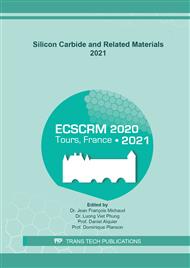p.549
p.554
p.560
p.565
p.570
p.576
p.582
p.588
p.593
Edge Terminations for 4H-SiC Power Devices: A Critical Issue
Abstract:
Edge termination is a critical part of a power devices. Numerous edge termination types have been developed for silicon devices. Implementation of these termination architectures are not straightforward in SiC due to physical and processing specificities: lower junction depths, higher electric field, trench depth and shaping limitations, etc. Two main families of terminations are currently used in commercial devices, pure Field Guard Rings, and JTE + Rings combination. The increasing number of trench commercial devices requires new approaches based on etched rings filled with dielectrics or polysilicon. For epitaxied bipolar devices, MESA with bevel angle termination combined with JTE based architecture are also suitable. In any case, and especially regarding avalanche capability requirements, not only the termination architecture is relevant, but also the passivation type, the channel stopper design, the 3D design. As modelling using conventional tools is not fully reliable, specific complementary characterization methods are needed. For instance, micro-OBIC can be very effective to determine the electric field distribution in the periphery of the power devices.
Info:
Periodical:
Pages:
570-575
Citation:
Online since:
May 2022
Authors:
Keywords:
Permissions:
Share:
Citation:


